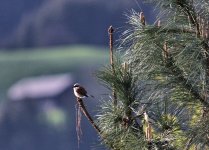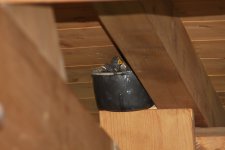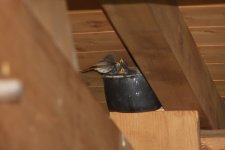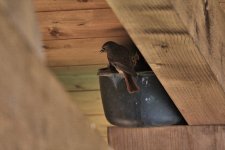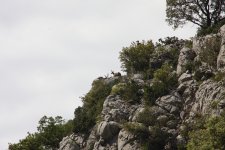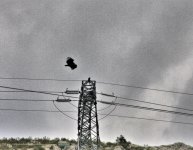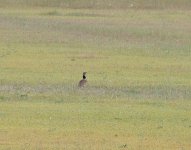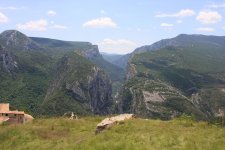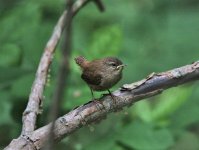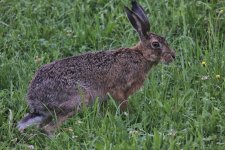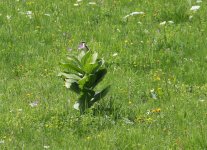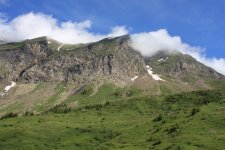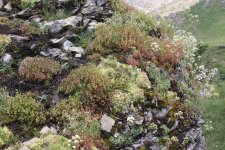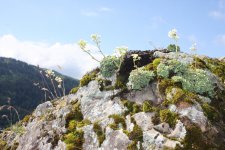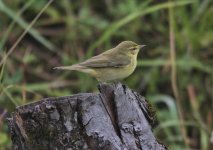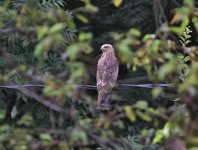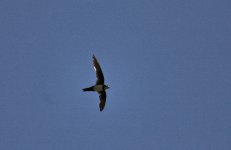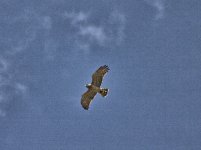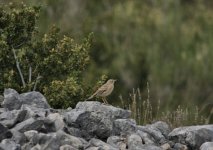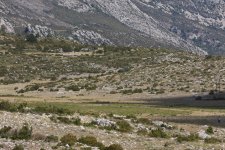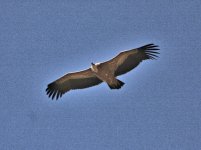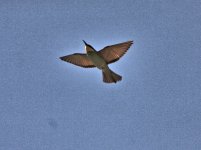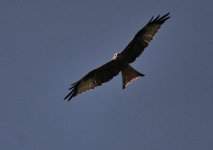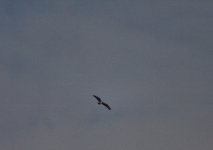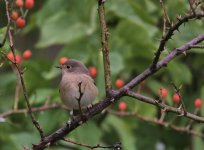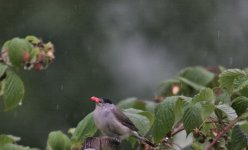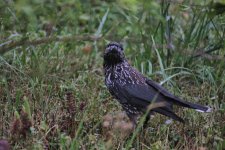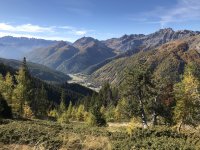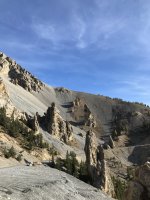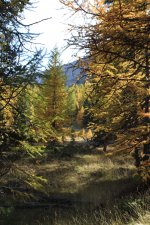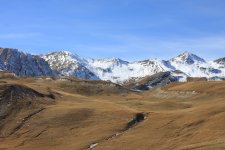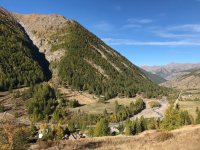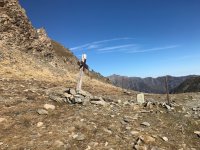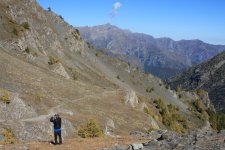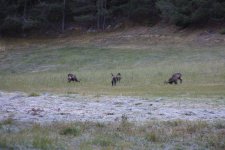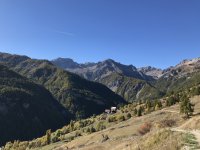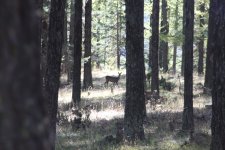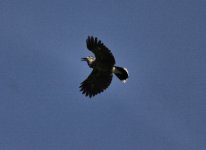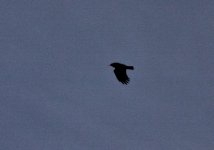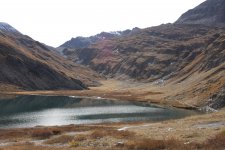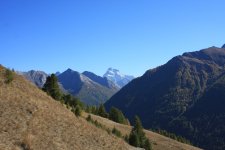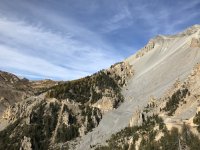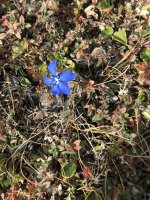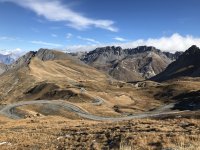-
Welcome to BirdForum, the internet's largest birding community with thousands of members from all over the world. The forums are dedicated to wild birds, birding, binoculars and equipment and all that goes with it.
Please register for an account to take part in the discussions in the forum, post your pictures in the gallery and more.
You are using an out of date browser. It may not display this or other websites correctly.
You should upgrade or use an alternative browser.
You should upgrade or use an alternative browser.
Birding halfway up the Alps (1 Viewer)
- Thread starter Richard Prior
- Start date
More options
Who Replied?Richard Prior
Halfway up an Alp

Synchronised Shrikes
With the trees now in leaf but regular snow higher up the views recently have indeed been impressive, this morning being a classic.
It rained hard all night but stopped just before dawn to give a crisp (bracing!), sunny morning. I've been keeping an eye out for the first Red-backed Shrike around the valley and yesterday produced the first one, giving the characteristic coughing call from atop a tall tree near the house (photo from today's visit attached). If it had been any further away I would have failed to hear it as the local farm's herd of cows were proudly wearing their summer bells ready for today's trek up to their summer pasture and making a healthy racket just grazing (when they passed by this morning it was deafening and as I type this two hours later I can still hear them even though they're a good 2kms away high on the mountain opposite!).
Anyway, back to shrikes, I never fail to be moved by their arrival here, day after day I look out for them and as soon as one arrives they all do! This morning I set up the telescope by the back door and scanned the area between home and the village, I found five males dotted around the valley sides, yesterday's bird was calling nearby and shortly afterwards a seventh flew high NE, all males! This is hopefully a sign of a successful overwintering and safe migration after last year's productive breeding season hereabouts. Photo of the nearest bird attached. Meanwhile the Black Redstart chicks are big enough to see as they poke their heads over the edge of their saucepan home (see photos). I'm a bit worried for the Blue Tit young as a lonely female Great Spotted Woodpecker (her mate taken by a Sparrowhawk I think) has come and tapped hard around the entrance hole to the tit's nestbox, so far the adults have not been put off and I have taken down all my feeders in the hope that she'll keep her distance from now on.
With no chores possible (the veg plot is drenched so no planting today) I spent this morning doing some sedentary birding (ie, within 100m of the house) and clocked up 32 species! Highlights in no particular order: Red Kite, Black Kite, Lammergeier, Whinchat, Alpine Chough, Jay and the ever-present Yellowhammers.
With the trees now in leaf but regular snow higher up the views recently have indeed been impressive, this morning being a classic.
It rained hard all night but stopped just before dawn to give a crisp (bracing!), sunny morning. I've been keeping an eye out for the first Red-backed Shrike around the valley and yesterday produced the first one, giving the characteristic coughing call from atop a tall tree near the house (photo from today's visit attached). If it had been any further away I would have failed to hear it as the local farm's herd of cows were proudly wearing their summer bells ready for today's trek up to their summer pasture and making a healthy racket just grazing (when they passed by this morning it was deafening and as I type this two hours later I can still hear them even though they're a good 2kms away high on the mountain opposite!).
Anyway, back to shrikes, I never fail to be moved by their arrival here, day after day I look out for them and as soon as one arrives they all do! This morning I set up the telescope by the back door and scanned the area between home and the village, I found five males dotted around the valley sides, yesterday's bird was calling nearby and shortly afterwards a seventh flew high NE, all males! This is hopefully a sign of a successful overwintering and safe migration after last year's productive breeding season hereabouts. Photo of the nearest bird attached. Meanwhile the Black Redstart chicks are big enough to see as they poke their heads over the edge of their saucepan home (see photos). I'm a bit worried for the Blue Tit young as a lonely female Great Spotted Woodpecker (her mate taken by a Sparrowhawk I think) has come and tapped hard around the entrance hole to the tit's nestbox, so far the adults have not been put off and I have taken down all my feeders in the hope that she'll keep her distance from now on.
With no chores possible (the veg plot is drenched so no planting today) I spent this morning doing some sedentary birding (ie, within 100m of the house) and clocked up 32 species! Highlights in no particular order: Red Kite, Black Kite, Lammergeier, Whinchat, Alpine Chough, Jay and the ever-present Yellowhammers.
Attachments
Last edited:
Richard Prior
Halfway up an Alp

I see another month has passed since my last exciting contribution  so time for another update perhaps. The last week of May saw the return of our most obvious (ie. big birds!) arriving summer visitors, Honey Buzzard, Short-toed Eagle and Griffon Vulture and the 22nd to 24th saw a pulse of Whinchat and a single Wheatear in the valley, leaving it pretty late to return to their breeding grounds. My persistent knee grumbling prevented me from any long hikes to check higher up for Lesser Whitethroat and Marsh Warbler but next week I hope to finally drive up to the Col de La Colombière where both are possible (and I will be taking my hiking poles ). My second Covid vaccine jab was on 31st and I not only heard the Nightingale singing outside the vaccine centre as on my first visit but also a very vocal Melodious Warbler, a couple of species that are definitely not likely “halfway up this alp” though as I discovered more recently they are happy enough at 1000m in the south. Being a bit rusty after missing birding away from my very local patch in most of 2020 I played the Melodious song on my phone to make sure it was indeed that species, this had the surprising effect of bringing a Nightingale out of the bushes just 2m away from me, the Melodious moved higher up in a tree so I could watch that too, all in all a successful morning
so time for another update perhaps. The last week of May saw the return of our most obvious (ie. big birds!) arriving summer visitors, Honey Buzzard, Short-toed Eagle and Griffon Vulture and the 22nd to 24th saw a pulse of Whinchat and a single Wheatear in the valley, leaving it pretty late to return to their breeding grounds. My persistent knee grumbling prevented me from any long hikes to check higher up for Lesser Whitethroat and Marsh Warbler but next week I hope to finally drive up to the Col de La Colombière where both are possible (and I will be taking my hiking poles ). My second Covid vaccine jab was on 31st and I not only heard the Nightingale singing outside the vaccine centre as on my first visit but also a very vocal Melodious Warbler, a couple of species that are definitely not likely “halfway up this alp” though as I discovered more recently they are happy enough at 1000m in the south. Being a bit rusty after missing birding away from my very local patch in most of 2020 I played the Melodious song on my phone to make sure it was indeed that species, this had the surprising effect of bringing a Nightingale out of the bushes just 2m away from me, the Melodious moved higher up in a tree so I could watch that too, all in all a successful morning !
!
As in 2020, our two weeks in Armenia had to be cancelled (for one thing the airline is banned from flying in EU airspace 😮!) but we did actually go somewhere outside a 50kms radius of home for the first time since November 2019, offering to transport an aunt and my Mum in law 400kms down to a cousin’s place in Provence, we stayed three nights in the area near the Gorge du Verdon and therefore had two full days sightseeing and birding. We stayed in the little market town of Aups in the far north of Var Département on the border with Alpes de Haute Provence (thus qualifying for this Alp related thread ahem…) Although places like St Tropez are also in Var the towns and countryside where we stayed felt a world away from the tourist sun, sand and …. is it saucisse ? resorts of the coast. 9 June Day 1 was spent firstly at the market in Aups, then passing via Riez (market day there too, what’s that all about?) we went up onto the Valensole Plateau (passing a small roadside Bee Eater colony on the way), famous for its huge expanse of lavender fields (which weren’t quite yet in flower so the plateau was virtually devoid of people ). At least one pair of Black-headed Buntings had arrived there a few days before but as no birders were to be seen we had no proper idea of their location (they’re ten a penny in Armenia anyway!) so we picknicked under some welcome shade-providing trees, serenaded by Nightingale and Subalpine Warblers, Woodlark and Ortolan Bunting, all producing an unfamiliar soundtrack for us ‘northern Alpers’. Quail sounded to be numerous and a single Tawny Pipit flew across the road at one point. After a bit of shopping and a welcome beer at Gréaux, a spa town which was a bit more touristy , we made a slight diversion to Vinon aerodrome near Manosque where we had good views of two Little Bustard wandering in and out of the longer grass. A Roller and then a Hoopoe on roadside wires completed the day and we got back to our hotel just as an enormous thunderstorm broke (this happened on each of the three evenings we were in the area in fact).
? resorts of the coast. 9 June Day 1 was spent firstly at the market in Aups, then passing via Riez (market day there too, what’s that all about?) we went up onto the Valensole Plateau (passing a small roadside Bee Eater colony on the way), famous for its huge expanse of lavender fields (which weren’t quite yet in flower so the plateau was virtually devoid of people ). At least one pair of Black-headed Buntings had arrived there a few days before but as no birders were to be seen we had no proper idea of their location (they’re ten a penny in Armenia anyway!) so we picknicked under some welcome shade-providing trees, serenaded by Nightingale and Subalpine Warblers, Woodlark and Ortolan Bunting, all producing an unfamiliar soundtrack for us ‘northern Alpers’. Quail sounded to be numerous and a single Tawny Pipit flew across the road at one point. After a bit of shopping and a welcome beer at Gréaux, a spa town which was a bit more touristy , we made a slight diversion to Vinon aerodrome near Manosque where we had good views of two Little Bustard wandering in and out of the longer grass. A Roller and then a Hoopoe on roadside wires completed the day and we got back to our hotel just as an enormous thunderstorm broke (this happened on each of the three evenings we were in the area in fact).
The idea for Day 2 was to get up to the ‘French Grand Canyon’, the Gorge du Verdon, do a couple of roadside stops to admire the spectacular scenery then do a hike up onto a ridge in the afternoon. But we dawdled a bit (as you do) as there were some lovely flowers by the winding road alongside the gorge, plus some good birds too, eg. Alpine Swifts and Crag Martins, more smart male Subalpine Warblers, soaring Golden Eagle, Griffon Vulture, Peregrine and Common Kestrel. A Chamois posed for photos on a distant crag too. The fairly recent Where to Watch Birds in France mentions that our planned ‘sandwich pick up’ village at La Palud ‘has Italian Sparrows’, in the end we opted for a sit down lunch at the Snack de Joe and sure enough, among the House Sparrows and two House /Italian hybrids was a cracking Italian Sparrow, a lot of villages in the more easterly French Alpine villages have them nowadays but it added a plus to the delicious lunch! Storm clouds were already gathering as we set off on our hike from Rougon later but we managed some exercise before the rain arrived, great views, flowers and vultures (two Cinerous as well as Griffons), Red-billed Chough and a hovering Short toed Eagle). Frustratingly I heard but couldn’t see a Blue Rock Thrush. Bonelli’s Warblers were common almost everywhere we went during our 'mini break'. The curfew in France was extended to 23h during our visit, so we ate at our cousin’s place that evening, seeing Cirl Bunting and hearing that characteristic Mediterranean sound, calling Scops Owl! At one point I got all excited thinking I could hear Nightjar churring but as it continued non-stop for quite a while with no change of note I guess I was hearing some sort of toad instead - oops. We only had a basic camera so no gripping bird photos but I attach a few anyway
As in 2020, our two weeks in Armenia had to be cancelled (for one thing the airline is banned from flying in EU airspace 😮!) but we did actually go somewhere outside a 50kms radius of home for the first time since November 2019, offering to transport an aunt and my Mum in law 400kms down to a cousin’s place in Provence, we stayed three nights in the area near the Gorge du Verdon and therefore had two full days sightseeing and birding. We stayed in the little market town of Aups in the far north of Var Département on the border with Alpes de Haute Provence (thus qualifying for this Alp related thread ahem…) Although places like St Tropez are also in Var the towns and countryside where we stayed felt a world away from the tourist sun, sand and …. is it saucisse
The idea for Day 2 was to get up to the ‘French Grand Canyon’, the Gorge du Verdon, do a couple of roadside stops to admire the spectacular scenery then do a hike up onto a ridge in the afternoon. But we dawdled a bit (as you do) as there were some lovely flowers by the winding road alongside the gorge, plus some good birds too, eg. Alpine Swifts and Crag Martins, more smart male Subalpine Warblers, soaring Golden Eagle, Griffon Vulture, Peregrine and Common Kestrel. A Chamois posed for photos on a distant crag too. The fairly recent Where to Watch Birds in France mentions that our planned ‘sandwich pick up’ village at La Palud ‘has Italian Sparrows’, in the end we opted for a sit down lunch at the Snack de Joe and sure enough, among the House Sparrows and two House /Italian hybrids was a cracking Italian Sparrow, a lot of villages in the more easterly French Alpine villages have them nowadays but it added a plus to the delicious lunch! Storm clouds were already gathering as we set off on our hike from Rougon later but we managed some exercise before the rain arrived, great views, flowers and vultures (two Cinerous as well as Griffons), Red-billed Chough and a hovering Short toed Eagle). Frustratingly I heard but couldn’t see a Blue Rock Thrush. Bonelli’s Warblers were common almost everywhere we went during our 'mini break'. The curfew in France was extended to 23h during our visit, so we ate at our cousin’s place that evening, seeing Cirl Bunting and hearing that characteristic Mediterranean sound, calling Scops Owl! At one point I got all excited thinking I could hear Nightjar churring but as it continued non-stop for quite a while with no change of note I guess I was hearing some sort of toad instead - oops. We only had a basic camera so no gripping bird photos but I attach a few anyway
Attachments
Richard Prior
Halfway up an Alp

21 June My annual meet up with Bittern (of this parish) at the Col de La Colombière, only three or four vehicles at the col at 09h00 but that soon changed and by the time we redescended to the road at 13h it was as busy as an August weekend and the col resounded to the sound of dozens of passing or tarrying motorbikes and flashy sports cars. It’s a great spot for Alpine species but I’d recommend early starts (weekdays only) especially if any of you come in the summer holidays! What with my nagging knee pain and Bittern’s slowly recovering Achilles tendon strain we must have looked a sorry sight, taking our ascension from the roadside very slowly. Still it allowed us to spend more time to admire the usual suspects, fantastic display song flights by a Rufous tailed Rock Thrush (a pair a bit higher up our walk were food carrying already) and busy parenting duties also being performed by Water and Tree Pipit, Wheatear, Linnet, Ring Ousel and Black Redstart. The local Lammergeier (parents of the bird that visited England last year) were patrolling the mountainside from time to time and a few Griffon Vulture were up and about by 10 o’clock. Knowing that we wouldn’t be climbing that high I opted to carry my ’scope instead of taking a camera so no photos this year. To be sure of seeing Snowfinch and Alpine Accentor it’s necessary to go further up the path at least to the Lac de Peyre but the former can sometimes be glimpsed flying out from the cliff faces by scanning from our chosen viewpoint much lower down (hence the ‘scope). Bittern got lucky seeing the unmistakeable big white patches on one bird against a blue patch of sky, I didn’t manage to see it and the other passerines I glimpsed way up there were always against the cloud and thus unidentifiable. Other species we saw or heard around the Col were Cuckoo, Kestrel, Alpine Chough, Carrion Crow, Raven, Crag Martin, Whinchat, Blackbird, Chiffchaff, Blackcap, Red-backed Shrike, Chaffinch, Citril Finch, Goldfinch, Siskin and Yellowhammer. After a slowly served beer and lunch at the col’s restaurant/bar (they were run off their feet, struggling to cope with the hordes of people) we didn’t try along the other track to Montarquis where Lesser Whitethroat breed but opted to stroll along the tarmacked lane to Aufferand farm to try for the Marsh Warblers reported from there. On reflection mid-afternoon under an increasingly threatening sky provided probably the least likely conditions for the species and so it proved. Bu it was nice to bird with another birder for the first time for a year (and the beer was good too ).
).
Later in the week (24th) my wife and I went just out of Haute Savoie and into Savoie to do the walk we first experienced last year the other side of the Col des Aravis. Several of the same species as seen at Colombière but as we were at around 1300 and not 1600m in a more open mountain pasture rather than rocky habitat there were more Whinchat and Red backed Shrike and no Rock Thrush, Citril or Crag Martin for example. Some superb flowers and ‘rockery plants’ to be seen and a pair of Red billed Chough were a nice surprise and I finally got to hear Garden Warbler this year in the bushes at the start of our hike.
Hearing Red-backed Shrike actually singing is a rare experience for me, they can have a beautiful, varied song but the volume is never that high, so it was a real treat watching and listening to one going through its repertoire while we had our picnic. This individual played a cruel trick on me, managing a perfect imitation of Rock Partridge twice (still, that would suggest the partridge must be somewhere in the vicinity…). Loads of Marmot in that area including two standing on their hind legs going at each other like the Ali-Foreman Rumble in the Jungle!
Nearer home I discovered a pair of Whinchat are breeding between our house and the village, visible (through the ‘scope) from home, I only saw one from home for the first time this spring so it’s a real surprise. Red-backed Shrike numbers are good again this year, I found nine territory holding males last week all within 1km of the house, including one pair in the field where the farmer had grubbed out their nesting bushes a few weeks back, so I was worrying for nothing! Other local breeders are having a tough time with some of the severe storms I suspect (and next door’s cat ), though I found a family of Wren nearby last week that seemed to be thriving. Mammal news around the house, a very young Roe Deer was lying in the field opposite early one morning, but moved off with its mother when she returned, we are also getting daily visits by one or two Brown Hare, they are getting closer and closer to my veg garden, so I hope the fencing I put around it will keep them off the carrots!
), though I found a family of Wren nearby last week that seemed to be thriving. Mammal news around the house, a very young Roe Deer was lying in the field opposite early one morning, but moved off with its mother when she returned, we are also getting daily visits by one or two Brown Hare, they are getting closer and closer to my veg garden, so I hope the fencing I put around it will keep them off the carrots!
Pics of one of the Wren family, Brown Hare, Whinchat on a Yellow Gentian, landscape and rock plants on our walk.
Later in the week (24th) my wife and I went just out of Haute Savoie and into Savoie to do the walk we first experienced last year the other side of the Col des Aravis. Several of the same species as seen at Colombière but as we were at around 1300 and not 1600m in a more open mountain pasture rather than rocky habitat there were more Whinchat and Red backed Shrike and no Rock Thrush, Citril or Crag Martin for example. Some superb flowers and ‘rockery plants’ to be seen and a pair of Red billed Chough were a nice surprise and I finally got to hear Garden Warbler this year in the bushes at the start of our hike.
Hearing Red-backed Shrike actually singing is a rare experience for me, they can have a beautiful, varied song but the volume is never that high, so it was a real treat watching and listening to one going through its repertoire while we had our picnic. This individual played a cruel trick on me, managing a perfect imitation of Rock Partridge twice (still, that would suggest the partridge must be somewhere in the vicinity…). Loads of Marmot in that area including two standing on their hind legs going at each other like the Ali-Foreman Rumble in the Jungle!
Nearer home I discovered a pair of Whinchat are breeding between our house and the village, visible (through the ‘scope) from home, I only saw one from home for the first time this spring so it’s a real surprise. Red-backed Shrike numbers are good again this year, I found nine territory holding males last week all within 1km of the house, including one pair in the field where the farmer had grubbed out their nesting bushes a few weeks back, so I was worrying for nothing! Other local breeders are having a tough time with some of the severe storms I suspect (and next door’s cat
Pics of one of the Wren family, Brown Hare, Whinchat on a Yellow Gentian, landscape and rock plants on our walk.
Attachments
birdmeister
Well-known member

A dizzying array of succulents there Richard, all in their natural element too! Very nice.
Richard Prior
Halfway up an Alp

Yes BM, lots of saxifrage species (I think), I attach a photo of another one for you!
I spoke too soon re. the encouraging Red-backed Shrike situation, the much wetter than usual June and July here resulted in a fair few nesting failures for them. Around the village there were definitely fewer than usual juvvie passerines to be seen, our Black Redstart pair lost all four youngsters in their first 24 hours after fledging thanks to the Jays (who had two of their own hungry mouths to feed) and the cats, they nested for a second time (actually on the house that has two feline inhabitants) and managed to successfully raise one young to independence. No Garden Warbler pair on my patch this year either, which was a shame and it was August before a Bonelli’s Warbler deigned to visit our garden when I also finally got to see a Willow Warbler this year (a heard only in most springs but the young birds are more friendly it seems!). Other nestbox results on the house were better, both Blue and Great Tit successful but the White Wagtail pair that nested on the house next door had a similar experience with the Jays I fear, only one juvenile around the house after fledging anyway. Plenty of other pairs of both Black Redstart and White Wagtail did OK later in the summer though…Woodpeckers (Black, Green and Great Spotted) have all done well as have birds of prey, for the first time we had a pair of Common Kestrel breed very close to home and the offspring are still buzzing around noisily as we arrive at mid- September and I’ve seen young Peregrine, Goshawk and Sparrowhawk during the summer, plus a juvenile Golden Eagle for the local pair that failed last year. There also seems to be a new Lammergeier pair establishing themselves, several times seen together but finding their nest will be another matter! Only two or three views of Short-toed Eagle in this period but I'm sure there's a pair not too far from home. Tawny Owl young heard a few times from August too. As always seems to happen, the first Hobby I see around home turned up exactly as the first Swallow and House Martin young start wandering up the valley, 28 June the date this year. The last few days of July and the beginning of August see the Common Swift briefly increase (migrating birds adding to the small local population) and luckily I had the camera handy when three Alpine Swift joined in the fun. The other early departures are the Black Kite which have done well despite the wet, on 3 August one young bird picked up a mouse that was dead on the road just outside the house before posing on the electricity wire, lovely upperparts plumage I think you’ll agree. Although we’re a bit off-piste as far as soaring birds migration goes I managed to see a group of 12 Honey Buzzard heading south on 28 August (to put that in perspective the spotters at the watchpoint south of Geneva had 816 the day before!) So no trips to exotic locations or twitches undertaken (Batumi and Georgia cancelled as expected), the rarest bird I found was a Grasshopper Warbler on 13 August which perched up very nicely for me when I flushed it from some wild raspberries as I made my way up to Mum in Law’s place for some garden work (personally I don’t think the species is rare in our area as I seem to find them each Aug/Sept both here and at our previous place, perhaps it’s because most birders go to the same well known spots rather than patrolling the field edges as I tend to do in this period).
I spoke too soon re. the encouraging Red-backed Shrike situation, the much wetter than usual June and July here resulted in a fair few nesting failures for them. Around the village there were definitely fewer than usual juvvie passerines to be seen, our Black Redstart pair lost all four youngsters in their first 24 hours after fledging thanks to the Jays (who had two of their own hungry mouths to feed) and the cats, they nested for a second time (actually on the house that has two feline inhabitants) and managed to successfully raise one young to independence. No Garden Warbler pair on my patch this year either, which was a shame and it was August before a Bonelli’s Warbler deigned to visit our garden when I also finally got to see a Willow Warbler this year (a heard only in most springs but the young birds are more friendly it seems!). Other nestbox results on the house were better, both Blue and Great Tit successful but the White Wagtail pair that nested on the house next door had a similar experience with the Jays I fear, only one juvenile around the house after fledging anyway. Plenty of other pairs of both Black Redstart and White Wagtail did OK later in the summer though…Woodpeckers (Black, Green and Great Spotted) have all done well as have birds of prey, for the first time we had a pair of Common Kestrel breed very close to home and the offspring are still buzzing around noisily as we arrive at mid- September and I’ve seen young Peregrine, Goshawk and Sparrowhawk during the summer, plus a juvenile Golden Eagle for the local pair that failed last year. There also seems to be a new Lammergeier pair establishing themselves, several times seen together but finding their nest will be another matter! Only two or three views of Short-toed Eagle in this period but I'm sure there's a pair not too far from home. Tawny Owl young heard a few times from August too. As always seems to happen, the first Hobby I see around home turned up exactly as the first Swallow and House Martin young start wandering up the valley, 28 June the date this year. The last few days of July and the beginning of August see the Common Swift briefly increase (migrating birds adding to the small local population) and luckily I had the camera handy when three Alpine Swift joined in the fun. The other early departures are the Black Kite which have done well despite the wet, on 3 August one young bird picked up a mouse that was dead on the road just outside the house before posing on the electricity wire, lovely upperparts plumage I think you’ll agree. Although we’re a bit off-piste as far as soaring birds migration goes I managed to see a group of 12 Honey Buzzard heading south on 28 August (to put that in perspective the spotters at the watchpoint south of Geneva had 816 the day before!) So no trips to exotic locations or twitches undertaken (Batumi and Georgia cancelled as expected), the rarest bird I found was a Grasshopper Warbler on 13 August which perched up very nicely for me when I flushed it from some wild raspberries as I made my way up to Mum in Law’s place for some garden work (personally I don’t think the species is rare in our area as I seem to find them each Aug/Sept both here and at our previous place, perhaps it’s because most birders go to the same well known spots rather than patrolling the field edges as I tend to do in this period).
Attachments
Richard Prior
Halfway up an Alp

We finally got away for a proper holiday on 30 August, 6 days in….. the French Alps, not our French Alps but the more southerly bit, in Alpes de Haute Provence département in fact, so still birding halfway up the Alps, just with wild lavender and box tree bushes and oak clad lower slopes instead of our larch, pines and nettles! Our little Fiat Panda made it over the Col du Galibier (2650m altitude) which is the unofficial frontier between the Northern and Southern Alps I’m told. Despite it being a glorious day, warm fleeces were required to keep us warm on our high altitude picnic, lots of Water Pipit, Linnet and single Northern Wheatear and Griffon Vulture the only birds seen, frustratingly a Snowfinch heard only (there’s a lot of scree and cliff faces to scan which is my excuse for missing it!). Overnight in Digne les Bains, a typical Provencal town but something was missing, I took a while to realise it was the absence of Swifts screaming around the rooftops and streets, something I associate with the villages and towns of Provence. Typically there were Jackdaw roosting noisily in the market square plane trees though which reassured me somewhat.
Day 1 We did the tourist bit around Digne (lavender museum, botanic gardens etc) but some birding at our riverside picnic stop produced a Golden AND a Short-toed Eagle, loads of Blackcap, a croaking Common Nightingale and a skulking Garden Warbler, Late afternoon we continued our journey to our accommodation for the next five nights, an auberge overlooking the Gorges du Verdon. Notices everywhere concerning the water shortage (the hotel only has spring water, no mains, so no soaking in a nice bath etc (a shame as some evenings after a long walk my knees could have done with that!!)).
Day 2 Walked from the hotel (at 780m asl) through Rougon village and on up to the Suech Plateau, a real slog in the hot sun as on this southern side of the plateau there was little shade (and I was lugging my camera and zoom lens), plenty of scrub and bushes so the ubiquitous Subalpine Warbler very much in evidence, if impossible to photograph, they are real skulkers in this habitat. A few migrants on the move on the ascent to the plateau at 1240m, Red-backed Shrike, Common Whitethroat and Willow Warbler and the first of many Green Lizards we were to see during our stay. Up on the grassy plateau there were plenty of Tawny Pipit, a few Stonechat and a solitary Northern Wheatear and a Short-toed Eagle flew over carrying a good sized snake in its bill, a second bird also present. We were perhaps a bit late to locate either Ortolan Bunting or Orphean Warbler which breed up there. A pair of Red billed Chough noisily announced their presence and of course the Griffon Vulture were constantly in view. A distant falcon on some wires turned out to be a Common Kestrel (Lesser Kestrel does disperse onto some of these plateaux after breeding and before migrating in late August/September so it’s important to check out any Kestrel sp at this time of year). The long descent back to our hotel was a bit tough on the knees but we forgot any discomfort when we started to hear the unmistakeable bubbling calls of Bee Eaters! Luckily a migrating flock of around 50 birds dropped down from the sky to feed around us on the slopes, a magical 15 minutes before they swirled up and headed south. Back at the hotel the Griffons and one Cinerous Vulture were flying by en route to their Cliffside roost and at least 100 Alpine Swift were feeding with a few Common Swift and good numbers of House Martin and Barn Swallow. As dusk fell we realised the hotel was a roosting site for White Wagtail, around 40 arrived from the depths of the Verdon Gorge below us.
Day 3
With our limbs surprisingly ache free we decided to go up to the Plateau again, this time starting from the northern side from the village of Chasteuil, a short 15 minute drive down into the gorge and out again. Although the walk’s distance was longer than the previous day’s, the start point in the village was higher up and we found it a more pleasant hike all round, nowhere really steep and the majority shaded by the oak trees which only petered out around 1000m. More birdy too, though for the most part the commoner woodland species as at home. As I had found carrying the camera a bit tiring the day before and as we were heading for the same destination I had decided to leave it behind this time (also meaning we could carry more water!). As you all know, Murphy’s Law is bound to come into play after a decision like that, so naturally a smart immature Subalpine Warbler perched up and posed uncharacteristically on a bush right next to our picnic stop and the Chough pair did a fly past! As I often say to my wife “If we leave the camera behind we’ll see more interesting things!”
A Dartford Warbler was less cooperative but a nice addition to the week’s list, I had forgotten they were present here, in France I think I have only seen them on Ouessant. But as we made our way down the track from the plateau the following two events proved the accuracy of my ‘no camera good sightings’ maxim. First, a ghostly pale grey shape lifted off from some long grass, a superb male Montagu’s Harrier which proceeded to quarter some overgrown pasture, brilliant! About 15 minutes further down we heard a blood curdling howl from way above us to the left (a ridge at about 2000m altitude). Immediately a howl in reply on the other side followed by the strangest yelping, almost like children shouting – but the schools had gone back the day before…. Scanning the mountainside to our east towards the noise I jammed in on an unforgettable scene, an adult Wolf sat in a clearing with three or four others slinking around it (they seemed to be not quite as big). My wife was able to watch them too and saw them run off into deeper forest. This ranks as one of my best ever moments with wildlife, not least because it was unexpected! A discreet enquiry with a member of the hotel staff with whom we had already discussed our birding efforts the day before (you never know who is pro or anti-Wolf) confirmed that there had been a couple of reports from up there last winter.
Day 4
A lazy day (ie, no walks!) shopping and lunch in nearby Castellane (Town of a Thousand Campsites should be its other name) and lounging on the decking outside our room was about it. In Castellane the church and Town Hall had Crag Martin and House Martin still busy feeding their young and the highlight back at the hotel was seeing an adult Bonelli’s Eagle over the cliff face on the other side of the gorge, a French tick and the first I’ve seen anywhere for the last 29 years! A Chamois up on the cliff too and a Pipistrelle sp flew out from above our window as night fell.
Day 5
Our last day saw us do a walk from the hotel to La Palud sur Verdon, about 13kms there and back but fortunately with little climbing involved. Right at the start we flushed a Tawny Pipit and nearby spied a Firecrest, Subalpine Warbler, Common Whitethroat and several Willow Warblers. En route we added a few more species for the week such as Short toed Treecreeper, Common Buzzard, Sparrowhawk, Black, Green and Great Spotted Woodpecker, Chiffchaff, Cirl Bunting, Common Redstart, Pied Flycatcher, Bullfinch, Crested and Marsh Tit. We ate lunch at Chez Joe, just as we had on our brief visit to the area in June, and just as before a male Italian Sparrow was in the vicinity, a bit scruffier in its post breeding moult and still managing to avoid the café’s pesky cat, a Collared Dove there too. A family group of five Serin greeted us on our weary return to the hotel just as the heavens opened for the only rain of the week – result!
Photos of Bee Eater, Griffon Vulture, the Plateau de Suech, Tawny Pipit and Short-toed Eagle.
Day 1 We did the tourist bit around Digne (lavender museum, botanic gardens etc) but some birding at our riverside picnic stop produced a Golden AND a Short-toed Eagle, loads of Blackcap, a croaking Common Nightingale and a skulking Garden Warbler, Late afternoon we continued our journey to our accommodation for the next five nights, an auberge overlooking the Gorges du Verdon. Notices everywhere concerning the water shortage (the hotel only has spring water, no mains, so no soaking in a nice bath etc (a shame as some evenings after a long walk my knees could have done with that!!)).
Day 2 Walked from the hotel (at 780m asl) through Rougon village and on up to the Suech Plateau, a real slog in the hot sun as on this southern side of the plateau there was little shade (and I was lugging my camera and zoom lens), plenty of scrub and bushes so the ubiquitous Subalpine Warbler very much in evidence, if impossible to photograph, they are real skulkers in this habitat. A few migrants on the move on the ascent to the plateau at 1240m, Red-backed Shrike, Common Whitethroat and Willow Warbler and the first of many Green Lizards we were to see during our stay. Up on the grassy plateau there were plenty of Tawny Pipit, a few Stonechat and a solitary Northern Wheatear and a Short-toed Eagle flew over carrying a good sized snake in its bill, a second bird also present. We were perhaps a bit late to locate either Ortolan Bunting or Orphean Warbler which breed up there. A pair of Red billed Chough noisily announced their presence and of course the Griffon Vulture were constantly in view. A distant falcon on some wires turned out to be a Common Kestrel (Lesser Kestrel does disperse onto some of these plateaux after breeding and before migrating in late August/September so it’s important to check out any Kestrel sp at this time of year). The long descent back to our hotel was a bit tough on the knees but we forgot any discomfort when we started to hear the unmistakeable bubbling calls of Bee Eaters! Luckily a migrating flock of around 50 birds dropped down from the sky to feed around us on the slopes, a magical 15 minutes before they swirled up and headed south. Back at the hotel the Griffons and one Cinerous Vulture were flying by en route to their Cliffside roost and at least 100 Alpine Swift were feeding with a few Common Swift and good numbers of House Martin and Barn Swallow. As dusk fell we realised the hotel was a roosting site for White Wagtail, around 40 arrived from the depths of the Verdon Gorge below us.
Day 3
With our limbs surprisingly ache free we decided to go up to the Plateau again, this time starting from the northern side from the village of Chasteuil, a short 15 minute drive down into the gorge and out again. Although the walk’s distance was longer than the previous day’s, the start point in the village was higher up and we found it a more pleasant hike all round, nowhere really steep and the majority shaded by the oak trees which only petered out around 1000m. More birdy too, though for the most part the commoner woodland species as at home. As I had found carrying the camera a bit tiring the day before and as we were heading for the same destination I had decided to leave it behind this time (also meaning we could carry more water!). As you all know, Murphy’s Law is bound to come into play after a decision like that, so naturally a smart immature Subalpine Warbler perched up and posed uncharacteristically on a bush right next to our picnic stop and the Chough pair did a fly past! As I often say to my wife “If we leave the camera behind we’ll see more interesting things!”
A Dartford Warbler was less cooperative but a nice addition to the week’s list, I had forgotten they were present here, in France I think I have only seen them on Ouessant. But as we made our way down the track from the plateau the following two events proved the accuracy of my ‘no camera good sightings’ maxim. First, a ghostly pale grey shape lifted off from some long grass, a superb male Montagu’s Harrier which proceeded to quarter some overgrown pasture, brilliant! About 15 minutes further down we heard a blood curdling howl from way above us to the left (a ridge at about 2000m altitude). Immediately a howl in reply on the other side followed by the strangest yelping, almost like children shouting – but the schools had gone back the day before…. Scanning the mountainside to our east towards the noise I jammed in on an unforgettable scene, an adult Wolf sat in a clearing with three or four others slinking around it (they seemed to be not quite as big). My wife was able to watch them too and saw them run off into deeper forest. This ranks as one of my best ever moments with wildlife, not least because it was unexpected! A discreet enquiry with a member of the hotel staff with whom we had already discussed our birding efforts the day before (you never know who is pro or anti-Wolf) confirmed that there had been a couple of reports from up there last winter.
Day 4
A lazy day (ie, no walks!) shopping and lunch in nearby Castellane (Town of a Thousand Campsites should be its other name) and lounging on the decking outside our room was about it. In Castellane the church and Town Hall had Crag Martin and House Martin still busy feeding their young and the highlight back at the hotel was seeing an adult Bonelli’s Eagle over the cliff face on the other side of the gorge, a French tick and the first I’ve seen anywhere for the last 29 years! A Chamois up on the cliff too and a Pipistrelle sp flew out from above our window as night fell.
Day 5
Our last day saw us do a walk from the hotel to La Palud sur Verdon, about 13kms there and back but fortunately with little climbing involved. Right at the start we flushed a Tawny Pipit and nearby spied a Firecrest, Subalpine Warbler, Common Whitethroat and several Willow Warblers. En route we added a few more species for the week such as Short toed Treecreeper, Common Buzzard, Sparrowhawk, Black, Green and Great Spotted Woodpecker, Chiffchaff, Cirl Bunting, Common Redstart, Pied Flycatcher, Bullfinch, Crested and Marsh Tit. We ate lunch at Chez Joe, just as we had on our brief visit to the area in June, and just as before a male Italian Sparrow was in the vicinity, a bit scruffier in its post breeding moult and still managing to avoid the café’s pesky cat, a Collared Dove there too. A family group of five Serin greeted us on our weary return to the hotel just as the heavens opened for the only rain of the week – result!
Photos of Bee Eater, Griffon Vulture, the Plateau de Suech, Tawny Pipit and Short-toed Eagle.
Attachments
Richard Prior
Halfway up an Alp

To get my autumn migration fix I have to leave our narrow valley (which rightly doesn’t feature on the migration hot spots map of France to be honest) and head down to the watchpoint at Défile de l’Ecluse on the Rhône west of Geneva. This season they have already had a few goodies such as Black-winged Kite, Arctic Skua and at least two Pallid Harrier through but it was a bit quiet for my visit, still, 300 plus Red Kite in one afternoon isn’t bad and a nice Osprey passed over.
Back home a pretty female Common Redstart paid us a visit as did a less expected (at least at our altitude) Middle Spotted Woodpecker and we were subject to the usual raids of Jay and Blackcap to our raspberry patch and the Nutcracker to our hazelnut tree. Unlike in Spring when I diligently note the first arrival dates for our summer breeders, in Autumn birds slip away and it’s only later on that I think, hang on , not seen an xxx for a while, when was the last? Still, a few Griffon Vulture are hanging on even though all the sheep flocks have been brought down and the first herds of cows too. Brambling next week I wouldn’t be surprised!
Back home a pretty female Common Redstart paid us a visit as did a less expected (at least at our altitude) Middle Spotted Woodpecker and we were subject to the usual raids of Jay and Blackcap to our raspberry patch and the Nutcracker to our hazelnut tree. Unlike in Spring when I diligently note the first arrival dates for our summer breeders, in Autumn birds slip away and it’s only later on that I think, hang on , not seen an xxx for a while, when was the last? Still, a few Griffon Vulture are hanging on even though all the sheep flocks have been brought down and the first herds of cows too. Brambling next week I wouldn’t be surprised!
Attachments
birdboybowley
Well-known member.....apparently so ;)

Great stuff mate, esp the wolves!! Will have to come impose myself on u at some time now 😜
Richard Prior
Halfway up an Alp

I’d better stock up on pasta then Ads!Great stuff mate, esp the wolves!! Will have to come impose myself on u at some time now 😜
birdboybowley
Well-known member.....apparently so ;)

😂😂😂👍
Richard Prior
Halfway up an Alp

October and Queyras trip
Eat your heart out Mystic Meg, Brambling did indeed arrive as I hoped on 5th, the first ones for Haute-Savoie this autumn and although I saw no big flocks moving during month, a healthy group of c20 spent their October around the garden feeders. A few highlights from our part of the Alps in what was a mild and dry month on the whole included a single late Griffon Vulture on 29th, the juv. Female Golden Eagle circling above an unprecedented (for me anyway) FOUR Lammergeier on 28th, their behaviour suggesting they were visiting a carcass out of my sight behind the ridge they were around, four separate sightings of Goshawk near home (three were first year birds which often become more visible from late September to late October before becoming more discreet until spring display time) but just one Peregrine and our Kestrel family left for warmer climes by the 9th. Good numbers of the latter and Merlin have passed through the Défilé watchpoint mentioned in my last report and they’ve also had a bumper autumn for Red Kite (over 15,000 so far!), I hope to make a final visit soon as Common Crane are starting to pass through. As in a lot of Europe, the settled weather meant a quiet autumn migration for this birder, though no doubt good for the birds, so a solitary Redwing on 14th was a bit of a surprise, I feel lucky if I see one before November around here. Last sightings around the garden of Blackcap (9th) White Wagtail (14th) Black Redstart (22nd) were typical, Chiffchaff are still about though and the Middle Spotted Woodpecker reappeared a few times.
and although I saw no big flocks moving during month, a healthy group of c20 spent their October around the garden feeders. A few highlights from our part of the Alps in what was a mild and dry month on the whole included a single late Griffon Vulture on 29th, the juv. Female Golden Eagle circling above an unprecedented (for me anyway) FOUR Lammergeier on 28th, their behaviour suggesting they were visiting a carcass out of my sight behind the ridge they were around, four separate sightings of Goshawk near home (three were first year birds which often become more visible from late September to late October before becoming more discreet until spring display time) but just one Peregrine and our Kestrel family left for warmer climes by the 9th. Good numbers of the latter and Merlin have passed through the Défilé watchpoint mentioned in my last report and they’ve also had a bumper autumn for Red Kite (over 15,000 so far!), I hope to make a final visit soon as Common Crane are starting to pass through. As in a lot of Europe, the settled weather meant a quiet autumn migration for this birder, though no doubt good for the birds, so a solitary Redwing on 14th was a bit of a surprise, I feel lucky if I see one before November around here. Last sightings around the garden of Blackcap (9th) White Wagtail (14th) Black Redstart (22nd) were typical, Chiffchaff are still about though and the Middle Spotted Woodpecker reappeared a few times.
My wife had a well - deserved week’s leave mid-month so we decided to discover - you guessed it - another part of the French Alps - the Queyras area which is in Hautes-Alpes département(05). If you look at a map of France, find Grenoble, then Briançon to its south east, south east of there you’ll see an area that’s half surrounded by Italy - that’s the Queyras, an area almost enclosed by mountains, riddled with river valleys. The slopes predominately clad with larch and some Arolla or Stone Pine, compared to our part of the Alps which is mostly pine and beech covered. With only c60 days of precipitation per year the high pasture areas were a lot browner than in our area and some impressive almost lunar landscapes were a feature.
I’ll do a brief account of each day which hopefully will give a flavour of the Queyras, which by the way is a very busy holiday region in summer (hiking, mountain biking, paragliding etc) and winter (skiing and snowshoeing etc). For the naturalist, May and June are fantastic for flowers and Alpine botany and higher density of bird species. October and early November are good for the vegetation colours, particularly the larch. As the emphasis was to be on long walks in the mountains I left the big lens at home, so apologies in advance for the lack of bird photos !
!
Day 1
Just as we had done for our Verdon trip at end August, we went over the Col du Galibier again, this time the few remaining Water Pipit still at the col had a few of their Meadow Pipit cousins with them and a Lammergeier passed low overhead as we stretched our legs. A few Alpine Chough were not a surprise, but a single Crossbill over and at least 3 Yellowhammer were less expected. An unfamiliar song at our picnic stop beside a small lake lower down the valley towards Briançon turned out to be a Dipper, although they’re common where we live, the noise of the rivers and streams they frequent usually means the song is inaudible (so that’s my excuse for not recognising it!).
To get into the Queyras we were able to drive over the Col d’Izoard (2360m or 7743 ft asl) which was still passable (I see it closed definitively last weekend, 30th October and will not reopen before late May/early June, so typically the road over the col is only open 5 months of the year!). Climbing up from Briançon towards the col we started to see the amazing autumn colours provided by the Mélèze (European larch) forests. A brief stop produced Crested and Coal Tit, Chiffchaff, Raven, Chaffinch, Bullfinch and Crossbill. The landscape around the Col itself is breathtaking, my French isn’t up to understanding geological terms but the photo hopefully shows that some dramatic events took place around 40 million years ago! Our hotel was a few kms below the col at La Chalp, although at 1700m asl the cows were still in the fields and some haymaking had just been completed, making us realise we were really ‘down south’ where the autumn and winter arrive a bit later than in our ‘up north’ Alps. A Willow Tit in the hotel garden reminded me that we were at an elevated altitude though (no Marsh Tit to be seen all week!).
Photos: First Brambling of the autumn at home; around the Col du Galibier (what was the Crossbill doing there??); first larch forests on the way up to the Col d’Izoard; landscape around the Col and view from the Col down to our accommodation site at La Chalp.
Eat your heart out Mystic Meg, Brambling did indeed arrive as I hoped on 5th, the first ones for Haute-Savoie this autumn
My wife had a well - deserved week’s leave mid-month so we decided to discover - you guessed it - another part of the French Alps - the Queyras area which is in Hautes-Alpes département(05). If you look at a map of France, find Grenoble, then Briançon to its south east, south east of there you’ll see an area that’s half surrounded by Italy - that’s the Queyras, an area almost enclosed by mountains, riddled with river valleys. The slopes predominately clad with larch and some Arolla or Stone Pine, compared to our part of the Alps which is mostly pine and beech covered. With only c60 days of precipitation per year the high pasture areas were a lot browner than in our area and some impressive almost lunar landscapes were a feature.
I’ll do a brief account of each day which hopefully will give a flavour of the Queyras, which by the way is a very busy holiday region in summer (hiking, mountain biking, paragliding etc) and winter (skiing and snowshoeing etc). For the naturalist, May and June are fantastic for flowers and Alpine botany and higher density of bird species. October and early November are good for the vegetation colours, particularly the larch. As the emphasis was to be on long walks in the mountains I left the big lens at home, so apologies in advance for the lack of bird photos
Day 1
Just as we had done for our Verdon trip at end August, we went over the Col du Galibier again, this time the few remaining Water Pipit still at the col had a few of their Meadow Pipit cousins with them and a Lammergeier passed low overhead as we stretched our legs. A few Alpine Chough were not a surprise, but a single Crossbill over and at least 3 Yellowhammer were less expected. An unfamiliar song at our picnic stop beside a small lake lower down the valley towards Briançon turned out to be a Dipper, although they’re common where we live, the noise of the rivers and streams they frequent usually means the song is inaudible (so that’s my excuse for not recognising it!).
To get into the Queyras we were able to drive over the Col d’Izoard (2360m or 7743 ft asl) which was still passable (I see it closed definitively last weekend, 30th October and will not reopen before late May/early June, so typically the road over the col is only open 5 months of the year!). Climbing up from Briançon towards the col we started to see the amazing autumn colours provided by the Mélèze (European larch) forests. A brief stop produced Crested and Coal Tit, Chiffchaff, Raven, Chaffinch, Bullfinch and Crossbill. The landscape around the Col itself is breathtaking, my French isn’t up to understanding geological terms but the photo hopefully shows that some dramatic events took place around 40 million years ago! Our hotel was a few kms below the col at La Chalp, although at 1700m asl the cows were still in the fields and some haymaking had just been completed, making us realise we were really ‘down south’ where the autumn and winter arrive a bit later than in our ‘up north’ Alps. A Willow Tit in the hotel garden reminded me that we were at an elevated altitude though (no Marsh Tit to be seen all week!).
Photos: First Brambling of the autumn at home; around the Col du Galibier (what was the Crossbill doing there??); first larch forests on the way up to the Col d’Izoard; landscape around the Col and view from the Col down to our accommodation site at La Chalp.
Attachments
Richard Prior
Halfway up an Alp

Day 2 16 October
Our idea was to do a really good walk each day and avoid driving for more than half an hour a day, the website Envie-de-Queyras.com had scores of suggested hikes for all levels of fitness/experience that can be downloaded onto a smartphone, though being an old fashioned git I still like to have a ‘proper’ paper map when I venture forth. As was to be the case each day, the morning dawned crisp (-1°C) and clear so after buying bread in the village shop we drifted down to the Guil river valley (passing a field containing a group of Chamois grazing away!)
After pootling alongside the river for about 20kms we parked up where the road ended at the hamlet of L’Echalp after Ristolas village and parked where the road ended beside the river at 1630m asl. The river has done some severe damage to the road and en route an ‘interesting’ temporary diversion is in place while some gigantic earthworks are going on to restore it, apparently at a safer height above the river which carries a lot of snowmelt water each spring. In May 1957 bridges and houses were swept away when a warm wet front caused a rapid thaw combined with heavy rain. From the parking spot we hiked right up to the Col Lacroix which is at 2300m, redescending on a different path. Surprisingly, the old knees coped pretty well! Birdwise it was quiet as I expected, especially in the wonderful ancient larch forest which constitutes the first half of the ascension. The forest is home to Tengmalm’s Owl (there is even a sign at each end of the forest explaining about the species!) and I would love to return there in Spring sometime……. just Crested Tit and Coal Tit heard and not seen, despite me doing a few Tengmalm’s imitations (or perhaps that should be read ‘because I did some Tengmalm’s imitations’ ). After a stiff climb we came out of the forest into an area of more stunted trees, juniper and bilberry bushes and immediately heard Black Grouse nearby. I can’t imitate the noise of a juicy juniper shoot so no sighting of the bubbling black galliforme unfortunately. A Siskin whizzed over but it was only when we reached a completely open area of grass and rocks towards the col that more avian life became evident, this last climb and at the col itself produced Golden Eagle, Crag Martin, Black Redstart, Water Pipit, Raven, Carrion Crow, Alpine and Red-billed Chough, Nutcracker, Chaffinch and Siskin. A small iron cross and a stone engraved with a fleur de lys next to a partly ruined small building indicated that we had arrived in Italy!! I imagine the col could be a good place for vis-migging in spring and autumn, a few Chaffinch moved south but the Siskin flock headed north from Italy into France suggesting they were not going anywhere in a hurry. A few Crossbill and Chiffchaff in the forest on the way back down were the only additions to the day’s meagre bird list.
). After a stiff climb we came out of the forest into an area of more stunted trees, juniper and bilberry bushes and immediately heard Black Grouse nearby. I can’t imitate the noise of a juicy juniper shoot so no sighting of the bubbling black galliforme unfortunately. A Siskin whizzed over but it was only when we reached a completely open area of grass and rocks towards the col that more avian life became evident, this last climb and at the col itself produced Golden Eagle, Crag Martin, Black Redstart, Water Pipit, Raven, Carrion Crow, Alpine and Red-billed Chough, Nutcracker, Chaffinch and Siskin. A small iron cross and a stone engraved with a fleur de lys next to a partly ruined small building indicated that we had arrived in Italy!! I imagine the col could be a good place for vis-migging in spring and autumn, a few Chaffinch moved south but the Siskin flock headed north from Italy into France suggesting they were not going anywhere in a hurry. A few Crossbill and Chiffchaff in the forest on the way back down were the only additions to the day’s meagre bird list.
Photos: Guil river at the start of the walk, Tengmalm’s territory, the French Italian border, trying to add to my Italian Life list , frosty morning Chamois.
, frosty morning Chamois.
Our idea was to do a really good walk each day and avoid driving for more than half an hour a day, the website Envie-de-Queyras.com had scores of suggested hikes for all levels of fitness/experience that can be downloaded onto a smartphone, though being an old fashioned git I still like to have a ‘proper’ paper map when I venture forth. As was to be the case each day, the morning dawned crisp (-1°C) and clear so after buying bread in the village shop we drifted down to the Guil river valley (passing a field containing a group of Chamois grazing away!)
After pootling alongside the river for about 20kms we parked up where the road ended at the hamlet of L’Echalp after Ristolas village and parked where the road ended beside the river at 1630m asl. The river has done some severe damage to the road and en route an ‘interesting’ temporary diversion is in place while some gigantic earthworks are going on to restore it, apparently at a safer height above the river which carries a lot of snowmelt water each spring. In May 1957 bridges and houses were swept away when a warm wet front caused a rapid thaw combined with heavy rain. From the parking spot we hiked right up to the Col Lacroix which is at 2300m, redescending on a different path. Surprisingly, the old knees coped pretty well! Birdwise it was quiet as I expected, especially in the wonderful ancient larch forest which constitutes the first half of the ascension. The forest is home to Tengmalm’s Owl (there is even a sign at each end of the forest explaining about the species!) and I would love to return there in Spring sometime……. just Crested Tit and Coal Tit heard and not seen, despite me doing a few Tengmalm’s imitations (or perhaps that should be read ‘because I did some Tengmalm’s imitations’
Photos: Guil river at the start of the walk, Tengmalm’s territory, the French Italian border, trying to add to my Italian Life list
Attachments
Richard Prior
Halfway up an Alp

Day 3 17 October
We had decided to walk to the Lac de Roue and although it’s possible to walk there directly from the hotel ( kms there and back) we chickened out and drove just 3kms to the imaginatively…. named hamlet of Les Maisons (1650m asl) and started our Sunday stroll from there. We were glad of the cool temperatures as the climb was through fairly open terrain, rough sheep grazing pasture with bushes and lots of thistles rather than forest, one of the first birds we saw after the hamlet was a stonking male Rock Bunting, other species in this sector included Common Buzzard, Great Spotted Woodpecker, a Tree Pipit, Robin, Stonechat, Mistle Thrush, several Chiffchaff, Jay, Carrion Crow, Raven, Chaffinch, Brambling, Goldfinch and c20 Crossbill. A couple of Clouded Yellow and a Red Admiral added to the increasingly late summery feel as the temperatures climbed. The very pretty lake at 1850 asl is on the edge of a larch forest, clearly not as old as the previous day’s and with a more grassy understory thanks to tree felling a few years back. This meant a much bigger selection of species than we had found in the forest on Day 2, well represented were Willow, Crested, Coal and Great Tit, Nuthatch, Common Treecreeper, Nutcracker, Chaffinch, Brambling, Siskin and Common Crossbill and we had a magical moment watching a Roe Deer strolling amongst the trees, a couple of Red Squirrel also seen. A White Wagtail was on the lake shore, soon disturbed by the increasing number of picknickers who were arriving (it was Sunday after all), most coming by car along a 3km dusty track…… Nevertheless we found a quiet spot to eat, quiet enough for me to be able to hear a Pygmy Owl making its autumn call, quite close by but unseen, typically shutting up as soon as I moved in its direction. The distant mountains had at least 11 Griffon Vultures, a Golden Eagle and a few Raven circling over them.
Nevertheless we found a quiet spot to eat, quiet enough for me to be able to hear a Pygmy Owl making its autumn call, quite close by but unseen, typically shutting up as soon as I moved in its direction. The distant mountains had at least 11 Griffon Vultures, a Golden Eagle and a few Raven circling over them.
Photos: Rock Bunting country at the lower part of the walk, the Lac de Roue, discreet Roe Deer, Nutcracker with a crop full of goodies.
We had decided to walk to the Lac de Roue and although it’s possible to walk there directly from the hotel ( kms there and back) we chickened out and drove just 3kms to the imaginatively…. named hamlet of Les Maisons (1650m asl) and started our Sunday stroll from there. We were glad of the cool temperatures as the climb was through fairly open terrain, rough sheep grazing pasture with bushes and lots of thistles rather than forest, one of the first birds we saw after the hamlet was a stonking male Rock Bunting, other species in this sector included Common Buzzard, Great Spotted Woodpecker, a Tree Pipit, Robin, Stonechat, Mistle Thrush, several Chiffchaff, Jay, Carrion Crow, Raven, Chaffinch, Brambling, Goldfinch and c20 Crossbill. A couple of Clouded Yellow and a Red Admiral added to the increasingly late summery feel as the temperatures climbed. The very pretty lake at 1850 asl is on the edge of a larch forest, clearly not as old as the previous day’s and with a more grassy understory thanks to tree felling a few years back. This meant a much bigger selection of species than we had found in the forest on Day 2, well represented were Willow, Crested, Coal and Great Tit, Nuthatch, Common Treecreeper, Nutcracker, Chaffinch, Brambling, Siskin and Common Crossbill and we had a magical moment watching a Roe Deer strolling amongst the trees, a couple of Red Squirrel also seen. A White Wagtail was on the lake shore, soon disturbed by the increasing number of picknickers who were arriving (it was Sunday after all), most coming by car along a 3km dusty track……
Photos: Rock Bunting country at the lower part of the walk, the Lac de Roue, discreet Roe Deer, Nutcracker with a crop full of goodies.
Attachments
Richard Prior
Halfway up an Alp

Days 4 and 5 18/19 October
| 18 Oct The rocky grassland slopes overlooking Ristolas village in the Guil valley are known to be the haunt of the mythical (for me at least) Rock Partridge so seeing that there was a walk on the website that partially involved climbing up those very slopes to a hidden pond it seemed rude not to try it! Needless to say as it was autumn the partridges were silently hiding (the hunting season also well underway of course) but we had a pleasant workout as the hike was a steep one and a few good birds seen. The highlight was early on, as we started climbing away from the river two Carrion Crows were doing their Goshawk alarm calls and dive bombing a larch about 500m away. Sure enough once we could see the tree properly the bulky (and sulky I imagine with all that pestering it was suffering) shape of a female Goshawk could be made out perched close to the trunk. Eventually it got fed up and drifted down river, followed (at a respectable distance of course) by the crows. At least three Rock Bunting, a Black Redstart and a Serin were near the river too and climbing up to the pond (Etang de Moussou) we saw (or more often heard) Chiffchaff and Robin in the low trees and bushes that punctuated the somewhat overgrown pasture habitat. Around the Etang itself the forest proper began, and with it a bigger variety of birdlife with signs of autumn movement, around half the 15 species seen were flyovers, namely Redwing, Mistle Thrush, Chaffinch, Brambling, Goldfinch, Siskin, Crossbill and Yellowhammer. Other species up there were Common Buzzard, Green Woodpecker, Robin, Chiffchaff, Coal Tit, Nutcracker and Carrion Crow. The impressive bulk of Mte Viso (3841asl) (where the Po river has its source) loomed in the distance to our south. On our way back down the valley on our return drive we stopped to buy some local honey in La Casse where a male sparrow looked like a typical Italian x House Sparrow hybrid, not uncommon in the area apparently. The nearby Col d’Agnel which carries the road into Italy was due to close for the winter the next day which explained the large number of Italian reg cars and groups of cyclists present, making the most of their last visit to Queyras until next June! 19 Oct Today was to be our most challenging hike, starting from the same spot by the river as on 16th at 1630m we planned to go up to Lac Egorgeou which meant staggering up to 2400m, would I need oxygen cylinders I pondered… As it happened it was a nice gradual climb taking us 3 hours to reach the lake, the colours of the larches became a more and more vivid orange the higher we went, in the forest and pasture edges were the usual suspects: Robin, Black Redstart (numerous), Mistle Thrush (at least 20 in one field), Willow, Crested and Coal Tit, Nuthatch and Common Treecreeper. A Dunnock was a surprise on the edge of the forest, investigating an area that Wild Boar had ploughed more efficiently than a Massey Ferguson (other brands of tractor are of course available Up at the lake a Dipper flew up the stream at one end and a White Wagtail was pottering on the shore. I heard Chaffinch fly over and a nice male Citril Finch did a tour of the lake as if it didn’t know which way to head. A high altitude Small Tortoiseshell was understandably having a rest on a sunny spot! On the grassy slopes were at least a dozen Red-billed Chough and a couple of Water Pipit. For the only time all week we heard a Marmot whistling. For the old knees the descent was less comfortable 😮 and in the forest we nearly got mown down by c20 mountain bikers who appeared to be testing out new models for one of France’s leading outdoor sports stores. Some of them had clearly fallen and looked a bit shaken up, more haste less speed etc etc. but we survived so my celebratory Pastis before our meal that night was well deserved IMO! Photos, Mt Viso from the er, ‘Rock Partridge’ slopes, track up to Lac Egorgeou, the lake itself, overflying Red-billed Chough plus one for the botanists. |
Attachments
Richard Prior
Halfway up an Alp

Day 6 20 Oct
Our last full day and our last lake to discover, this time a walk up to the Lac de Souliers (2500m asl, but we started at already 2150m so not too tough!) near the Col d’Izoard where the landscape is ‘mineral’, to put it mildly. A few woodland species at the start of the easy (and thus fairly well frequented) walk: Great Spotted Woodpecker, Fieldfare, Willow, Coal and Crested Tit, Nutcracker and Crossbill. Around the lake (two crazy people swam in it (for about ten seconds!)) were Water Pipit, Black Redstart, a lonely Raven, Goldfinch and Linnet. On the way back down I spotted two Carrion Crow in the distance, swooping down repeatedly at a what looked at first to be a large rock, through the bins I discovered that in fact it was a Golden Eagle and about ten minutes later as we neared the road it came overhead, being mobbed by a few Red-billed Chough, first time I’ve seen that. This was the only day that we saw other people birding, and in the spirit of sharing I pointed out an approaching Griffon Vulture to one gentlemen who responded ‘it can’t be a vulture, it’s on its own, they’re always in groups’, he had to reluctantly agree with me when it passed no more than 50m over our heads though! Back at the hotel a cute Wren came and sat on the balcony outside our window, the only one seen all week.
All too soon our Queyras trip came to an end so stocking up on local cheese, honey and Briancon micro-brewery beer we headed back up north to our corner of the French Alps, passing over the Col du Galibier once again (and once again still no Snowfinch to be seen, just more Yellowhammer, Water Pipit, Alpine Chough and small flocks of migrating Chaffinch). Arriving home we were greeted by the sight of the first Long - tailed Tits on our feeders since last winter, it was clearly time to get some firewood in!
Photos, more of that amazing lunar landscape, a late October Gentian, Lac de Souliers (with the Italian mountain Viso again in the distance) and the road up to Col du Galibier where the northern and southern French Alps meet, not for the faint-hearted!
Our last full day and our last lake to discover, this time a walk up to the Lac de Souliers (2500m asl, but we started at already 2150m so not too tough!) near the Col d’Izoard where the landscape is ‘mineral’, to put it mildly. A few woodland species at the start of the easy (and thus fairly well frequented) walk: Great Spotted Woodpecker, Fieldfare, Willow, Coal and Crested Tit, Nutcracker and Crossbill. Around the lake (two crazy people swam in it (for about ten seconds!)) were Water Pipit, Black Redstart, a lonely Raven, Goldfinch and Linnet. On the way back down I spotted two Carrion Crow in the distance, swooping down repeatedly at a what looked at first to be a large rock, through the bins I discovered that in fact it was a Golden Eagle and about ten minutes later as we neared the road it came overhead, being mobbed by a few Red-billed Chough, first time I’ve seen that. This was the only day that we saw other people birding, and in the spirit of sharing I pointed out an approaching Griffon Vulture to one gentlemen who responded ‘it can’t be a vulture, it’s on its own, they’re always in groups’, he had to reluctantly agree with me when it passed no more than 50m over our heads though! Back at the hotel a cute Wren came and sat on the balcony outside our window, the only one seen all week.
All too soon our Queyras trip came to an end so stocking up on local cheese, honey and Briancon micro-brewery beer we headed back up north to our corner of the French Alps, passing over the Col du Galibier once again (and once again still no Snowfinch to be seen, just more Yellowhammer, Water Pipit, Alpine Chough and small flocks of migrating Chaffinch). Arriving home we were greeted by the sight of the first Long - tailed Tits on our feeders since last winter, it was clearly time to get some firewood in!
Photos, more of that amazing lunar landscape, a late October Gentian, Lac de Souliers (with the Italian mountain Viso again in the distance) and the road up to Col du Galibier where the northern and southern French Alps meet, not for the faint-hearted!
Attachments
birdmeister
Well-known member

Fantastic photos and scenery Richard! Love these mountain updates.
Are some of the larger lakes good for migrating waterfowl, or do they tend to avoid these high elevations (save for Geese and Corms maybe)?
Are some of the larger lakes good for migrating waterfowl, or do they tend to avoid these high elevations (save for Geese and Corms maybe)?
foresttwitcher
Virtually unknown member

Love the landscape photos Richard.
Richard Prior
Halfway up an Alp

Thanks BM! No, the lakes don't see much if any wildfowl as far as I can ascertain and there isn't really any goose species that migrates through the region, small numbers of Greylag pass along the Rhône valley but I'm not sure whether they're really migrating or just making local movements. Cormorants don't mind flying over mountains though and there are fish in the lakes we visited so you never know....Fantastic photos and scenery Richard! Love these mountain updates.
Are some of the larger lakes good for migrating waterfowl, or do they tend to avoid these high elevations (save for Geese and Corms maybe)?
Similar threads
- Replies
- 0
- Views
- 456
Users who are viewing this thread
Total: 2 (members: 0, guests: 2)




